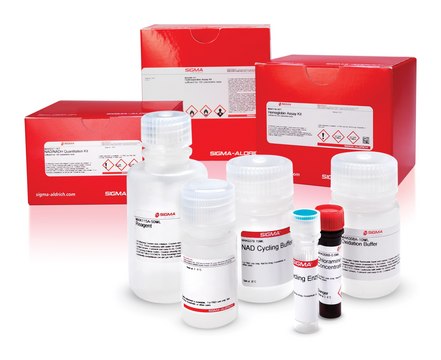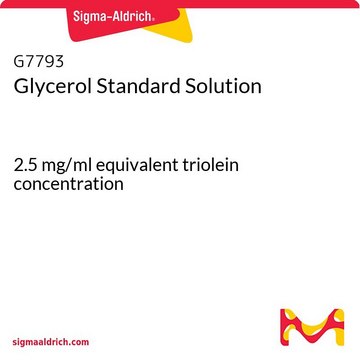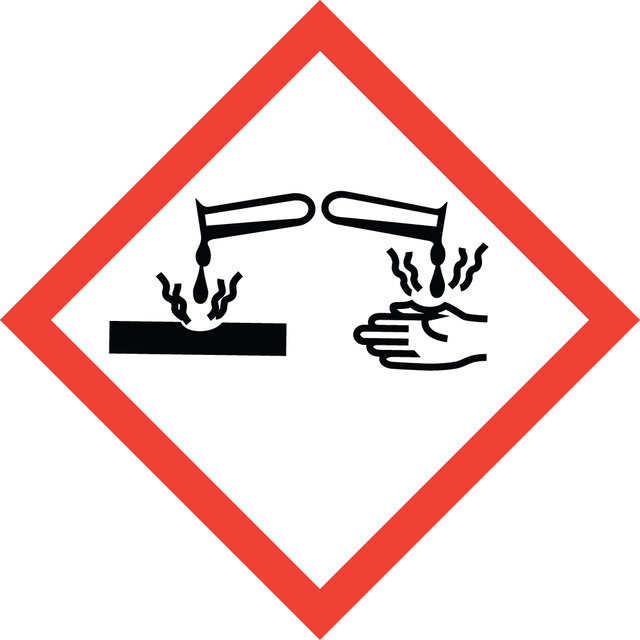TR0100
Kits et réactifs pour triglycérides et glycérol à l′état libre
1 kit sufficient for 250 tests
Synonyme(s) :
Triglyceride and Free Glycerol Kits and Reagents
Se connecterpour consulter vos tarifs contractuels et ceux de votre entreprise/organisme
About This Item
Code UNSPSC :
12352202
Nomenclature NACRES :
NA.26
Produits recommandés
Vous recherchez des produits similaires ? Visite Guide de comparaison des produits
Catégories apparentées
Description générale
The Serum Triglyceride Determination Kit is for the quantitative enzymatic measurement of glycerol, true triglycerides, and total triglycerides in serum or plasma at 540 nm. Triglycerides, esters of fatty acids and glycerol,1 do not circulate freely in plasma, but are bound to proteins and transported as macromolecular complexes called lipoproteins.2 Methods for triglyceride determination generally involve enzymatic3 or alkaline4 hydrolysis of triglycerides to glycerol and free fatty acids, followed by either chemical or enzymatic measurement of the glycerol released.
Application
Les kits pour triglycérides et glycérol à l′état libre sont utilisés pour la détermination quantitative du glycérol, des triglycérides totaux et des triglycérides à l′état libre.
A Serum Triglyceride Determination Kit was used to determine the level of triglycerides in whole-body homogenates of Drosophila melanogaster.
The Serum Triglyceride Determination Kit can be used for the measurement of glycerol, true triglycerides, or total triglycerides in serum or plasma. The procedure involves enzymatic hydrolysis by lipase of the triglycerides to glycerol and free fatty acids. The glycerol produced is then measured by coupled enzyme reactions. Many of the triglyceride reagents which are commercially available, do not differentiate between endogenous glycerol and glycerol derived by hydrolytic action of lipase on glycerides.
Triglycerides are first hydrolyzed by lipoprotein lipase to glycerol and free fatty acids. Glycerol is then phosphorylated by adenosine-5′-triphosphate (ATP) forming glycerol-1-phosphate (G-1-P) and adenosine-5′-diphosphate (ADP) in the reaction catalyzed by glycerol kinase (GK). G-1-P is then oxidized by glycerol phosphate oxidase (GPO) to dihydroxy-acetone phosphate (DAP) and hydrogen peroxide (H2O2). Peroxidase (POD) catalyzes the coupling of H2O2 with 4-aminoantipyrine (4-AAP) and sodium
N-ethyl-N-(3-sulfopropyl) m-anisidine (ESPA) to produce a quinoneimine dye that shows an absorbance maximum at 540 nm. The increase in absorbance at 540 nm is directly proportional to triglyceride concentration of the sample.
Triglycerides are first hydrolyzed by lipoprotein lipase to glycerol and free fatty acids. Glycerol is then phosphorylated by adenosine-5′-triphosphate (ATP) forming glycerol-1-phosphate (G-1-P) and adenosine-5′-diphosphate (ADP) in the reaction catalyzed by glycerol kinase (GK). G-1-P is then oxidized by glycerol phosphate oxidase (GPO) to dihydroxy-acetone phosphate (DAP) and hydrogen peroxide (H2O2). Peroxidase (POD) catalyzes the coupling of H2O2 with 4-aminoantipyrine (4-AAP) and sodium
N-ethyl-N-(3-sulfopropyl) m-anisidine (ESPA) to produce a quinoneimine dye that shows an absorbance maximum at 540 nm. The increase in absorbance at 540 nm is directly proportional to triglyceride concentration of the sample.
Conditionnement
The kit also includes sufficient reagent for an additional 250 free glyceride tests for true triglyceride determination.
Adéquation
Suitable for the quantitative determination of glycerol, total triglycerides or free triglycerides in serum or plasma
Principe
The Serum Triglyceride Determination Kit can be used for the measurement of glycerol, true triglycerides, or total triglycerides in serum or plasma. The procedure involves enzymatic hydrolysis by lipase of the triglycerides to glycerol and free fatty acids. The glycerol produced is then measured by coupled enzyme reactions. Many of the triglyceride reagents which are commercially available, do not differentiate between endogenous glycerol and glycerol derived by hydrolytic action of lipase on glycerides. Triglycerides are first hydrolyzed by lipoprotein lipase to glycerol and free fatty acids. Glycerol is then phosphorylated by adenosine-5′-triphosphate (ATP) forming glycerol-1-phosphate (G-1-P) and adenosine-5′-diphosphate (ADP) in the reaction catalyzed by glycerol kinase (GK). G-1-P is then oxidized by glycerol phosphate oxidase (GPO) to dihydroxy-acetone phosphate (DAP) and hydrogen peroxide (H2O2). Peroxidase (POD) catalyzes the coupling of H2O2 with 4-aminoantipyrine (4-AAP) and sodium N-ethyl-N-(3-sulfopropyl) m-anisidine (ESPA) to produce a quinoneimine dye that shows an absorbance maximum at 540 nm. The increase in absorbance at 540 nm is directly proportional to triglyceride concentration of the sample.
Liaison
En plus des kits, les réactifs individuels et le standard de glycérol sont disponibles pour réaliser un plus petit nombre de réactions.
Étalon
Réf. du produit
Description
Tarif
Mention d'avertissement
Danger
Mentions de danger
Conseils de prudence
Classification des risques
Acute Tox. 4 Oral - Aquatic Acute 1 - Aquatic Chronic 1 - Eye Dam. 1 - Skin Irrit. 2
Code de la classe de stockage
11 - Combustible Solids
Point d'éclair (°F)
Not applicable
Point d'éclair (°C)
Not applicable
Faites votre choix parmi les versions les plus récentes :
Déjà en possession de ce produit ?
Retrouvez la documentation relative aux produits que vous avez récemment achetés dans la Bibliothèque de documents.
Les clients ont également consulté
Notre équipe de scientifiques dispose d'une expérience dans tous les secteurs de la recherche, notamment en sciences de la vie, science des matériaux, synthèse chimique, chromatographie, analyse et dans de nombreux autres domaines..
Contacter notre Service technique






